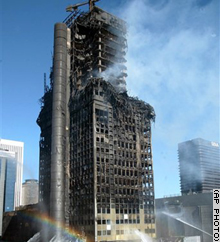But based on what you told us those engineers should never have worried about a fully loaded 707 because such thing wouldn't affect the building in any way more than a usual fire would.
Of course it would be considered, the same as they considered hurricane force winds on the buildings. They consider everything. An impact by an aircraft is not the same as a ‘usual’ fire because it involves various degrees of structural damage as well. Burning office furniture alone will not bring down a steel framed building because it will not get hot enough. We have seen recently in Dubai(?) a tower burning with sheets of flame up the whole of one side. The fire gutted the building and burned for hours but the structure did not collapse.
It is obvious that those smart engineers knew that a fully loaded 707 COULD bring such a building down which is why they even mentioned such a scenario.
Not correct! They considered the possibility and designed for it into the structure. It had happened before and in New York, when a Mitchel B25 crashed into the Empire State building, killing several people and doing structural damage. But even then the design allowed for distribution of the load in case of support column failure. The twin towers were designed to cope with the unexpected.
You may also remember that it was not the first time the WTC Tower had been attacked. A truck bomb was driven into the underground car park and exploded killing several. The building didn’t collapse but more by luck than judgement. Had the bomber parked against the column as he was told to, the blast would have taken out one of the main support columns. I read a report that said had he not parked 12’ away from the column, they were convinced it could have caused the structure, or at least part of it, to topple. (The details are on the Internet somewhere.)
Engineering can be an exact science only if you know all the variables and you make the correct calculations and no mistakes are made in the execution. However we have seen many times where engineering goes wrong... buildings and bridges collapsing, spaceships blown to pieces, space missions failing, airplane failures etc.
Many of these are unforeseen circumstances or multiple failures. The fact that both buildings stood for a long time before a very symmetrical collapse says their calculations were correct. Neither the impact or the following fires bought the building down .... so what did?
This becomes even more strange when this is applied to WTC 7, as there was no impact, no fuel fires and nothing but minor office furniture fires. Some critics point out that the side of WTC 7 facing the twin towers was badly damaged and it was. So, why did it not collapse on the weak side of the building, why did it go straight down into its own footprint, just like 1 and 2?
.In this case the variables of such event were possibly not fully known because such event was never tested in the real world. Theoretical models are often different from reality (especially in the 60s when they had far less computing power). Furthermore I doubt that they spend a great amount of time and resources to protect against such a scenario because the likelihood of such thing happening was rather small
Believe me they do take even the most unlikely causes into account ..... a sort of ‘what-if’ scenario. I know because I spent many years doing this same probability assessment on chemical plant control, safety and shut down systems. We even had to consider double jeopardy!
But the evidence that the official explanation is not correct and full of holes is hidden in full view!
All three buildings collapsed at something approaching free fall acceleration, that is a fact ...... and this is impossible if there is a structure that is creating a force to oppose the vertical descent of the structure above. In this case that was the central core of the building which below the impact point was completely undamaged and was designed to support the full weight, + some, of the whole tower structure. It was as if it didn’t exist! Had it been there the probability was 99% plus the towers would have toppled in another direction as it would be an inevitability that the load would at some point in the descent, become unequally distributed i.e. unbalanced. It would fall in the direction of least resistance.
From the point the collapse starts you go into the realm of theory and guesswork based on known parameters as it becomes increasingly obvious that what was happening was impossible ............ without some help! Strangely enough the 911 Commissions brief was to only look into what happened leading up to the impact .............. not the result!






